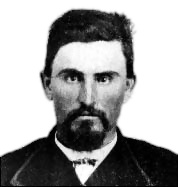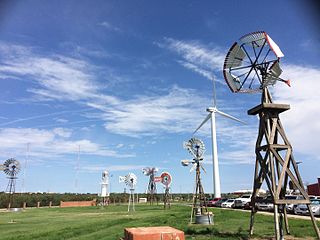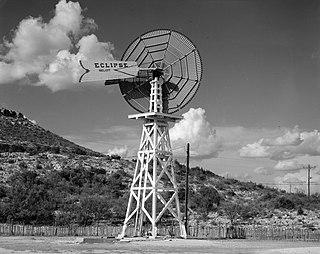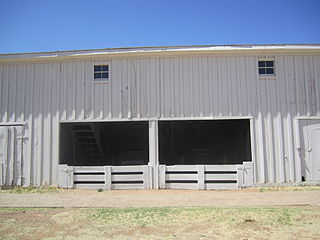
Lynn County is a county in the U.S. state of Texas. As of the 2020 census, its population was 5,596. Its county seat is Tahoka. The county was created in 1876 and organized in 1903.

Garza County is a county located in the U.S. state of Texas. As of the 2020 census, its population was 5,816, of which most of the population were residing in its county seat, and only incorporated municipality, Post. The county was created in 1876 and later organized in 1907. Garza is named for a pioneer Bexar County family, as it was once a part of that county.

Crosby County is a county located in the U.S. state of Texas. As of the 2020 census, its population was 5,133. The county seat is Crosbyton. The county was founded in 1876 and later organized in 1886. Both the county and its seat are named for Stephen Crosby, a land commissioner in Texas.

Hereford is a city in and county seat of Deaf Smith County, Texas, United States. It is 48 miles southwest of Amarillo. Its population was 14,972 at the 2020 census. It is the only incorporated locality named "Hereford" in the country.

Lubbock is a city in the U.S. state of Texas and the seat of Lubbock County. With a population of 266,878 in 2023, the city is the 10th-most populous city in Texas and the 84th-most populous in the United States. The city is in the northwestern part of the state, an area known historically and geographically as the Llano Estacado, and ecologically is part of the southern end of the High Plains, lying at the economic center of the Lubbock metropolitan area, which had an estimated population of 360,104 in 2023.

Charles Goodnight, also known as Charlie Goodnight, was a rancher in the American West. In 1955, he was inducted into the Hall of Great Westerners of the National Cowboy & Western Heritage Museum.

Oliver Loving was an American rancher and cattle driver. Together with Charles Goodnight, he developed the Goodnight-Loving Trail. He was mortally wounded by Native Americans while on a cattle drive.
Western lifestyle or cowboy culture is the lifestyle, or behaviorisms, of, and resulting from the influence of, the attitudes, ethics and history of the American western cowboy. In the present day these influences affect this sector of the population's choice of recreation, western wear, partaking of western cuisine and Southwestern cuisine, and enjoyment of the western genre and western music.

Russell "Red" Steagall is an American actor, musician, poet, and stage performer, who focuses on American Western and country music genres.

The American Wind Power Center is a museum of wind power in Lubbock, Texas. Located on 28 acres (110,000 m2) of city park land east of downtown Lubbock, the museum has more than 160 American style windmills on exhibition.
R. W. Hampton is an American western music singer-songwriter, actor and playwright. Hampton has achieved both critical and commercial success, winning multiple awards from the Western Music Association and the Academy of Western Artists and four separate Wrangler Awards from the National Cowboy & Western Heritage Museum in Oklahoma City.

The Canon Ranch Railroad Eclipse Windmill is a historic windpump that was located near Sheffield, Texas.

The Mt. Blanco Fossil Museum was a creationist museum in Crosbyton, Texas, United States, opened in 1998. Its motto was "Digging up the facts of God's Creation: One fossil at a time."
Christopher Columbus Slaughter (1837–1919) was an American rancher, cattle drover and breeder, banker and philanthropist in the Old West. After serving in the Confederate States Army during the American Civil War of 1861–1865, he came to own 40,000 cattle and over one million acres of ranch land in West Texas. He became the largest taxpayer in Texas, and used his wealth to endow Baptist institutions. He was known as the "Cattle King of Texas."
The Mallet Ranch is a historic ranch in Texas. It was established in Hockley County, Texas in the 1880s. It was used to raise Hereford cattle from the 1900s to the 1930s, with cotton fields added in the mid-1920s. By the late 1930s, oil was discovered. The ranch spanned 45,000 acres in 1990.

The Four Sixes Ranch, stylized as 6666 Ranch, is a ranch in King County, Texas as well as Carson County and Hutchinson County.
Robert Lee Slaughter (1870–1938) was an American rancher and oilman. He was the owner of ranches in Texas, US, and Sonora, Mexico.
William B. Slaughter was an American rancher, cattle driver, banker and county judge. Born into a ranching family, he drove cattle and ranched in New Mexico before acquired a ranch in Sherman County, Texas. He founded local banks in Texas and New Mexico, and he was tried but acquitted on suspicion of faulty loans. He retired in San Antonio, Texas.
John Bunyan Slaughter was an American rancher and banker. Born to a ranching family, Slaughter ranched in Texas and New Mexico before acquiring the U Lazy S Ranch in Garza County, Texas, in 1901 and managing it for nearly three decades.

The U Lazy S Ranch, formerly known as the Square and Compass Ranch, is a historic ranch in Garza County, Texas, USA.






































